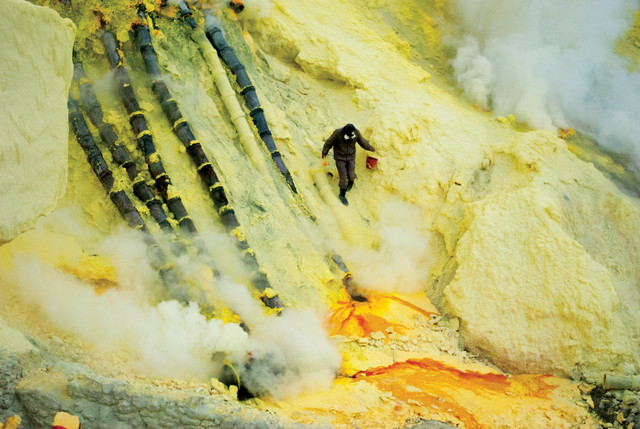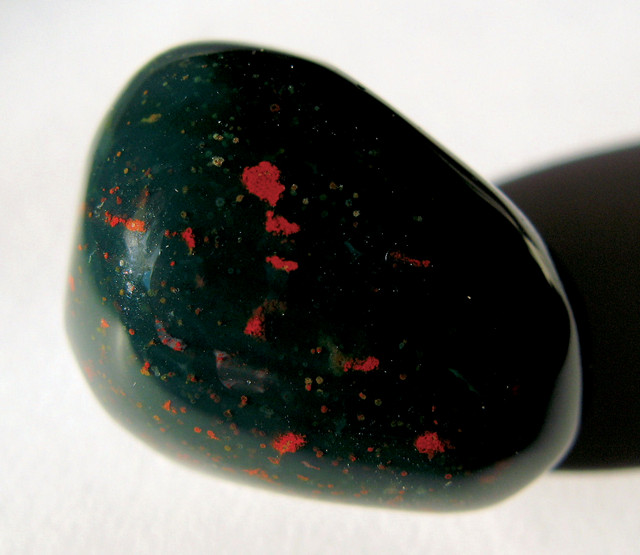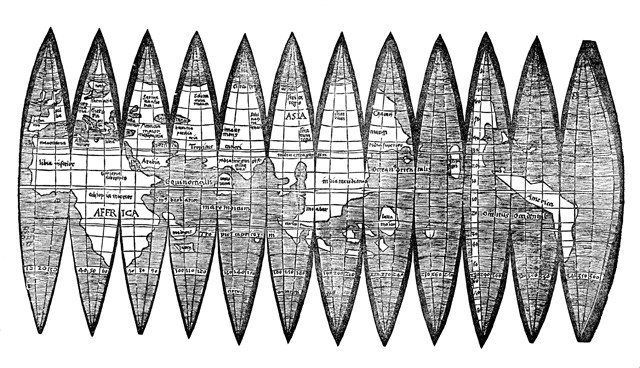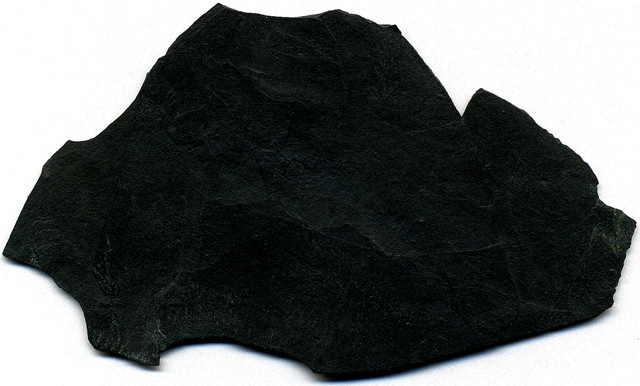
by Timothy Oleson Friday, September 7, 2018

This list of Halloween-themed geo-jargon is full of fire and brimstone! Or at least brimstone, which of course is just sulfur. It's smelly, but not necessarily scary, unless you're climbing down a sulfur-lined slope toward a steaming volcanic fumarole like this person. Credit: Nadj91, public domain.
I’m hardly fanatical about Halloween, but I am an impassioned lover of puns and word humor (the more Dad-like, the better). So when it occurred to me I could crack open my copy of the American Geoscience Institute’s “Glossary of Geology” (GoG) to scour it for some of the eerier sounding jargon within, it seemed a perfect way to acknowledge the day. Fear not … unlike with H.P. Lovecraft’s “Necronomicon,” there are no ancient or evil powers to be conjured by speaking these ghastly glossary entries. You might, however, summon an appreciation for some of the fiendish creativity and ghoulish humor that’s gone into earth science’s vast lexicon.
Among the entries below, I haven’t listed any spooky-sounding place names or specific geologic features — the list of locales with “devil” in the name could fill a book on its own. Of course, there are many others not listed, so feel free to contact us on Twitter or on Facebook to share any that you’d add.
A version of this piece previously appeared online at EARTH on Oct. 31, 2017.

No list of spooky geo-terms would be complete without bloodstone. Credit: Ra'ike, CC BY-SA 3.0.
GoG definition: A semitranslucent leek-green or dark-green variety of chalcedony speckled with red or brownish-red spots of jasper resembling drops of__ blood.__
An obvious choice, but one that’s hard to skip on a Halloween-themed list. Also known as heliotrope, bloodstone is primarily chalcedony with bits of reddish jasper, according to the Glossary. Other sources note that the “drops of blood” can also come from hematite.
GoG: A coal that burns with a bright white__ flame.__
This coal is known to contribute to anthropogenic apparitions — er, make that emissions.
GoG: A blue__ spinel.__
A slight stretch maybe, but I had to squeeze in a reference to candy — it’s Halloween after all! Besides, this variety of spinel — which is also known as ceylonite — is named for a city in Sri Lanka called Kandy, which Mindat spells as Candy … so I think it totally works.
GoG: A crystal within which an earlier stage of crystallization or growth is outlined by dust, tiny inclusions, mineral coatings or bubbles, e.g., serpentine containing a ghost or phantom of original__ olivine.__
Also known as a “ghost crystal.” Internet searches mostly turn up examples of phantom quartz — some of which are imbued with mystical or healing powers (and can be purchased for a low low price!) — but there are other examples to be sure, including the Halloween-appropriate mention of serpentine in the GoG entry.
GoG: A pale blue monoclinic mineral: NiCO__3__·6H__2__O__
With a name like hellyerite, you might expect this hydrous nickel carbonate mineral to have a reddish or orange coloration instead of pale blue or green. Then again, it wasn’t named for the underworld, but rather for Henry Hellyer, an English surveyor known for his exploration of Tasmania.
GoG: A cave in which there is no longer any moisture or any growth of speleothems associated with the presence of__ moisture.__
A scary place no doubt, where you might find preserved remains of the formerly living (also known as fossils). Perhaps a nightmare for an isotope geochemist searching for records of recent climate. “The speleothems [gasp] … they’re dead! They’re all dead!”
GoG: A graph in which the vertical axis is the ratio of the concentration of a trace element in a sample to the concentration of that element in some reference material (average chondritic meteorite, estimated primitive mantle, etc.). On the horizontal axis, the elements are arranged in order of their bulk partition__ coefficients.__
Also called “spidergrams,” these things can definitely be a fright up close, and they’ve certainly haunted the dreams of many a geoscience student. The description alone is cringe-worthy.
GoG: Apparent range extension of the fossils of an extinct organism due to reworking of those fossils into younger strata by sedimentary__ processes.__
OK, so it’s not exactly “The Walking Dead” or “World War Z,” but earth science’s version of the zombie effect sometimes throws a wrench into our understanding of the fossil record.

This is one gory map. Credit: public domain.
GoG: One of the series of related and triangular- or lune-shaped sections of a map or chart, usually bounded by meridians and tapering to the poles, which can be applied to the surface of a sphere to form a__ globe.__
So, you know how when a globe projection is flattened onto two dimensions, it looks like a side-by-side lineup of pointy, surfboard-looking shapes? Those surfboards are called “gores.” News to me!

Batt, or bat, is black shale interbedded with layers of coal. Credit: James St. John, CC BY 2.0.
GoG: An English term for a compact black carbonaceous shale, which splits into fine laminae and is often interstratified with thin layers of coal or__ ironstone.__
“Also spelled “bat.” I almost flew right by this one under “B” in the glossary. Luckily, my sixth sense (echolocation perhaps?) for frighteningly bad puns kicked in and led me to it.
GoG: An organism with extreme departure in form or structure, generally pathologic, from the usual type of its__ species.__
Is this the most scientific-sounding definition of a monster you’ve ever heard or what? Imagine trying to explain to a young child that there isn’t an “organism with extreme departure in form or structure, generally pathologic, from the usual type of its species” under the bed. Or, maybe there is … BOO!
GoG: A common or commercial name for sulfur, especially native sulfur or fine sulfur fused into rolls, sticks or__ blocks.__
How and when sulfur became known as brimstone I do not know. But I suppose ardent depictions of “fire and brimstone!” do evoke a more visceral sense of terror than scenes of “fire and sulfur!”
GoG: (a) An avalanche track down a steep slope. (b) A long narrow mass of talus material descending a steep__ mountain.__
Even if you’re tall enough, I’d recommend skipping this roller coaster.
GoG: A blue pearly variety of orthoclase that emits a fetid smell upon hammering. It occurs in limestone near Baltimore,__ Md.__
With a name suggestive of death, and perhaps a smell to match, there was no passing this over on my list of Halloween geo-jargon. The definition above starts off well … “A blue pearly variety of orthoclase” sounds lovely, right? But this is no ordinary potassium feldspar. If it were living, I’d think the fetid smell was an evolutionary adaptation that conveniently wards off predators. I confess to a morbid — er, let’s say scientifically curious — interest in smelling necronite myself someday. Thankfully, I don’t live far from Baltimore, so let the limestone sniffing begin!
© 2008-2021. All rights reserved. Any copying, redistribution or retransmission of any of the contents of this service without the expressed written permission of the American Geosciences Institute is expressly prohibited. Click here for all copyright requests.